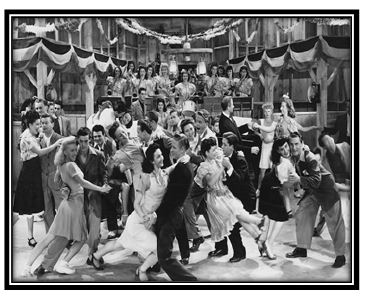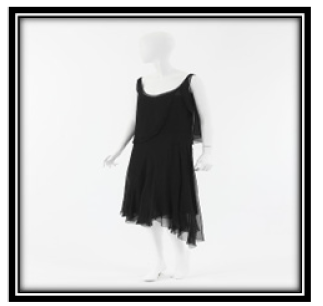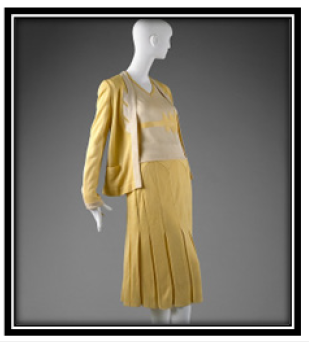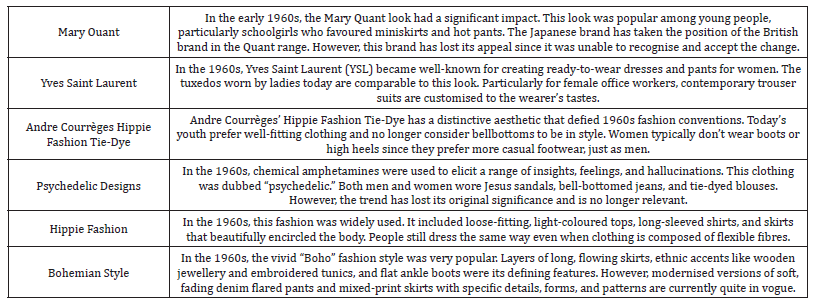- Submissions

Full Text
Trends in Textile Engineering & Fashion Technology
Review Study on Women’s Costumes & Knowledge 20th and 21st Centuries
Ushma Saini, Ramratan Guru* and Priyanka Yadav
Assistant Professor, School of Design, Mody University of Science and Technology, India
*Corresponding author:Ramratan Guru, Assistant Professor, School of Design, Mody University of Science and Technology, Lakshmangarh 332311, Rajasthan, India
Submission: August 18, 2023; Published: September 15, 2023

ISSN 2578-0271 Volume9 Issue2
Abstract
All around the world and in all climatic zones, clothes and textiles have been an important part of society since the dawn of time. People naturally used whatever was available to them. Textile and costume design evolved over time as artists added fabric and apparel. For traditional dress, the materials used, the colours used, the patterns utilized, and the way they are draped have all changed. The research paper focuses on how conventional clothes evolved during the twentieth and twenty-first centuries, as well as how postmodernism affected art, culture and fashion. One of the key issues of the twenty-first century is the development of practical models to capture, preserve, and transfer to future generations old knowledge systems and values. In the 20th and 21st centuries, the world underwent significant change. We have discussed women’s costumes and knowledge in this review study. so that everyone may grasp how clothing changes with ease.
Keywords:Postmodernism; 20th and 21st centuries textile costume; Inspiration cultural fashion
Introduction
A popular or novel style of dress, hair, accessories, or demeanour is said to be in fashion. It can also be considered a fashion trend, particularly in terms of apparel, haircuts, makeup, and other aesthetic elements. Most of the time, art is a vehicle for artists to express their thoughts and react to political, social, environmental, or economic issues. Fashion isn’t always founded on whims. Throughout history, there have been instances where current fashion trends were impacted by earlier events [1-2]. A component of the prevailing culture is fashion. It is influenced by how people employ their individual sense of style, the social, cultural, and political backdrop, moral standards, the state of the economy, and well-known individuals. Fashion is always changing because it is affected by so many things outside of it. Fashion is an important part of society because it is always changing and can be made to fit a person’s needs. Also, this makes fashion a powerful way to show yourself and talk to other people [3-5]. In the 20th and 21st centuries, the world underwent significant change. Two terrible world wars, the end of colonialism, the rise of human rights and racial equality, the rapid industrialization of all nations, the cold war, significant scientific advancements, a greater awareness of environmental issues, and shorter distances due to improved transportation and communication all occurred in the previous century.
Modernist abstract design
The 1920s are commonly referred to by design historians and critics in terms of modernism as the time when many arts started to work well together. A more conceptually sophisticated approach to beauty in fashion was produced as a result of the confluence of the fine arts, applied arts, and decorative arts [6,7]. The relationship between post-war art and design movements is strengthened by the way abstraction may be used to improve the appearance of everyday products by incorporating their aesthetic concerns into both fashion and textile design (Figure 1).
Figure 1:Aesthetic concerns both fashion and textile design.

According to Anscombe, “avant-garde” “abstract” art is simple enough for museums to embrace because it appears on textiles. Three renowned women artists used an abstract visual language that was “implicit in the development of modernism” in their works. Simple, geometric, flexible forms that resemble machine parts make up its structure [8].
Postmodernism and fashion
Fashion and Music: When Strauss’s music influenced the waltz and the magnificent dance attire of the 1800s, and when jazz from the 1920s gave the light Charleston dresses their swing. The 1930s “glamour” subculture in Hollywood grew as a result of the music of Rodgers and Hammerstein. Broadway shows and musical theatre have made a big difference in popular culture. Thanks to American Cab Calloway’s jazz sounds and the East Coast jazz movement, black Americans began adopting zoot suits as a form of social and political protest in 1943. Wide-lapel jackets and baggy pants added to the gangster look even though they broke the rules about how much cloth could be used during the war [9,10]. Black American rhythm and blues had an impact on rock & roll, which rose to prominence after World War II. This music was commonly linked to rebellion, youth, and a change in how society operated. Most of the people dancing wear full skirts, bobby socks, two-toned shoes, checkered red shirts, and skirt trousers (Figure 2). Due to their incredibly athletic and acrobatic motions, street dancers started donning unusually wide-cropped, low-hanging trousers and fashionable athletic footwear like Adidas, Nike and Puma. Punk rock and fashion were intertwined in the 1980s thanks to the promotion of rebellious, distinctive clothing by Vivienne Westwood and Malcolm McLaren using cheap, unusual materials. People donned T-shirts with splits and tears, rude wording, and other items with pop culture references as part of the anti-fashion protest ensemble [11,12]. People’s ideas about dance, music, fashion, and shows in general changed because of Johnny Rotten, Michael Jackson, and Madonna’s music videos. Not only did these media images affect what young people wore, but they also set standards for how to act, what to wear and how to take part in cultural practices (Figure 3).
Figure 2:Light Charleston dresses.

Figure 3:Participation in cultural practices dresses.

Postmodernism in fashion and art: At the time, people used the word “postmodernism” to describe the changes in design and design patterns from the 1960s to the growth of global businesses today. It is very antimodernist because it goes against the ideal style and idea of “good taste” in design that were popular between the two world wars [13,14]. You may also say “against high fashion.” It’s likely that deconstructivist methods were used to cut, make patterns, or sew, leading to a less-than-ideal outcome. The technological environment has given rise to new methods and instruments employed in postmodernist art and design. To compensate for this transition, designers and marketers rapidly changed how they thought about their target audiences.
Disposable fashion: Postmodern thought gave us cheap clothes and art that doesn’t last long. The ideas of value, tradition, and stability are in danger when there are fads or “short-lived” groups. Marcel Duchamp’s early works are being looked at again because of the “Neo-dadaism” art movement. The leading paper dress producer in America used the miracle fabric Kaycee, which was both fire- and water-resistant. The clothing’s label stated, “Waste Basket Boutique.” Three washings and ironings were possible for the disposable paper gowns made in London by Dispo. The French paper bikini fell apart when it got wet. Pop artists sought to return art to society as it had been in the 1700s by taking it “out of the galleries and into the streets.” This was without a doubt the most important cultural contribution made by paper clothing.
Youth Codes: the hippie movement
The anti-consumerist appeal of ethnic clothes was acknowledged by the bohemian movement. Additionally, it increased the cultural bond between the customer and the artwork garments in the late 1960s and early 1970s. This stood in opposition to technology and scientific practices. Young men and women wore Afghan coats and caftans, as well as jeans, cheesecloth tops, velvet cloaks, and velvet cloaks with slogans like “Make love, not war.” These outfits not only revealed the wearers’ opinions on marriage, parenting, and politics, but also hinted at shifts in sexual morality.
A counterculture that fought being transformed by American society came to be represented by the marijuana leaf, love necklaces, headbands, and handcrafted peace emblems. Hippies adopted Afro wigs, body and facial painting, and other international trends. Ceremonial love-ins and other tribal customs made people feel like they belonged to a group of outcasts and rule-breakers [15,16]. The Haight-Ashbury section of San Francisco served as the birthplace of the hippie movement, which spread fast to the rest of the nation.
Womenswear (1920-1929)
Figure 4:Women wear dresses..

When the 1920s began, the repercussions of the First World War were still being felt. Even though it ended a little more than a year before the start of the new decade, the war had a profound effect on society, culture, and fashion that lasted for a long time. The secret to these new fashion trends was a degree of simplicity in women’s attire that had never before been seen. The well-known tubular style, which dominated the decade, was born from this simplicity of use. The flapper style, often known as this design, was emblematic of 1920s apparel. It had a low waist and a short skirt that lengthened as it dropped. Part of the credit for this look’s fame goes to Coco Chanel, a well-known designer of the time. Waistlines were dropping until 1923, when they started to climb again. Hemlines climbed until 1926, when they started to fall again. Throughout the decade, hemlines and waistlines both saw similar but opposing changes [17] (Figure 4).
Another fashionable trend for women in the 1920s was activewear worn during the day. Sportswear has long been a mainstay of men’s casual dress, but women didn’t start to wear it until the 1920s. Much like many of the most well-liked fashions of the 1920s, sportswear is typically linked to Coco Chanel. However, other designers, such as Jane Regny and Jean Patou, also contributed to the advancement of the sportswear movement. Tennis clothing has influenced fashion, as seen in the yellow Patou skirt and pullover (Figure 5).
Figure 5:Yellow Patou skirt and pullover dresses.

In the 1920s, fashion was all about one’s whole appearance, and there were trends in how the body was dressed [18-20]. Neutral shapes and straightforward lines looked best on those with straight physiques. Women used a variety of shapewear styles, healthy eating habits, and exercise to try to achieve this look. Another factor influencing the popularity of sun-kissed skin was how fit people appeared. Many women cut their hair short to attain the bob style, which became popular at the start of the decade. As the decade came to an end, women once more began growing their hair longer. The considerably shorter Eton crop appeared after the sand. The cloche hat developed into a highly elegant addition at the time that these short hairstyles were in popularity (Table 1).
Table 1:Comparison of 20th and 21st century dress.

Conclusion
A. The person has occasionally shown an interest in clothing
throughout their life. Some of these clothes are hundreds of
years old, while others were created at the beginning of the
twenty-first century. People have traditionally been drawn to
garments and materials because of their distinctiveness and
sophistication.
B. The traditional attire gradually began to disappear. At first
glance, the more modern clothes are clearly distinguishable
from the more traditional dress. Younger generations are open
to other cultures and clothing styles.
C. They don a variety of Indian and Western clothes, as well as
contemporary clothing and traditional regalia. Young women
were found to be more fashion-experimental than older
women, who still favour more traditional apparel.
D. The twenty-first century’s female population has its own unique
accents and fashion sense. The socioeconomic circumstances
of tribal women have altered, and these sociocultural changes
are reflected in the alterations to their traditional clothing.
References
- Thakar K, Crill R, Fotheringham A, Houghteling S (2021) Indian textiles 1000 Years of art and design. Indian Books and Periodicals.
- Zimmer H (1946) Myths & Symbolic in Indian Art & Civilization. New York, USA.
- (2014) Traditional Indian Textiles Class XII Students Handbook + Practical Manual. The Secretary, Central Board of Secondary Education, Shiksha Kendra, Community Centre, Preet Vihar, Delhi, India.
- Bhatnaga P (2009) Traditional Indian Costumes and Textiles. Publisher by Abhishek Publication, India.
- Guru R, Saini U, Rani J (2023) To study on famous ancient traditional Indian costumes & Textiles. Trends in Textile Engineering & Fashion Technology 8(3): 953-960.
- Bhandar V (2004) Costume, textiles & jewellery of India Publisher by Prakash Books India Pvt. Ltd.-113A, Darya Ganj, New Delhi, India.
- Aaron J, Ardis AL, Armstrong TD (2004) The Cambridge history of twentieth-century English literature. Cambridge University Press. England.
- Chafe WH, Chafe WH (1992) The paradox of change: American women in the20th Oxford University Press on Demand, England.
- Majumdar RC (1955) The history & Culture of the Indian People. 7: 63-69, Bombay, India.
- Biswas A (2017) Indian costumes. Publications Division, M/O Information& Broadcasting, India.
- Ghurye GS (1995) Indian costumes. Popular Prakashan Pvt. Ltd, India.
- Biswas A (2007) Indian costumes. Publications Division Ministry of Information & Broadcasting, India.
- Burton AM (1994) Burdens of history: British feminists, Indian women, and imperial culture. Univ of North Carolina Press, USA.
- Alkazi R (1996) Ancient Indian ostume. National Book Trust, India.
- Longhurst AH (1938) The Buddhist Antiquities of Nagar Junakonda, A.S.I., Mem, No. 54, Delhi, India.
- Bachhofer I (1929) Early Indian sculpture, New York, USA, Volume 2.
- Burgess J (1892) Ancient monuments, temples & sculpture of India, London, UK, Volume 2.
- George R (1876) The seventh great oriental monarchy, London, UK.
- Kumar R, Muscat C (1999) Costumes and Textiles of Royal India. Christies Wine Pubns,
- Burgess J (1900) Gandhara Sculptures Journal of Indian Art, London, UK, Volume 8.
© 2023 Ramratan Guru. This is an open access article distributed under the terms of the Creative Commons Attribution License , which permits unrestricted use, distribution, and build upon your work non-commercially.
 a Creative Commons Attribution 4.0 International License. Based on a work at www.crimsonpublishers.com.
Best viewed in
a Creative Commons Attribution 4.0 International License. Based on a work at www.crimsonpublishers.com.
Best viewed in 







.jpg)






























 Editorial Board Registrations
Editorial Board Registrations Submit your Article
Submit your Article Refer a Friend
Refer a Friend Advertise With Us
Advertise With Us
.jpg)






.jpg)














.bmp)
.jpg)
.png)
.jpg)










.jpg)






.png)

.png)



.png)






